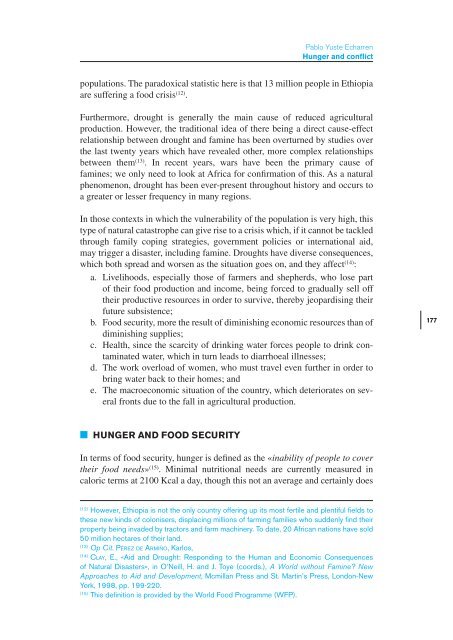Food security and global security - IEEE
Food security and global security - IEEE
Food security and global security - IEEE
- No tags were found...
Create successful ePaper yourself
Turn your PDF publications into a flip-book with our unique Google optimized e-Paper software.
Pablo Yuste EcharrenHunger <strong>and</strong> conflictpopulations. The paradoxical statistic here is that 13 million people in Ethiopiaare suffering a food crisis (12) .Furthermore, drought is generally the main cause of reduced agriculturalproduction. However, the traditional idea of there being a direct cause-effectrelationship between drought <strong>and</strong> famine has been overturned by studies overthe last twenty years which have revealed other, more complex relationshipsbetween them (13) . In recent years, wars have been the primary cause offamines; we only need to look at Africa for confirmation of this. As a naturalphenomenon, drought has been ever-present throughout history <strong>and</strong> occurs toa greater or lesser frequency in many regions.In those contexts in which the vulnerability of the population is very high, thistype of natural catastrophe can give rise to a crisis which, if it cannot be tackledthrough family coping strategies, government policies or international aid,may trigger a disaster, including famine. Droughts have diverse consequences,which both spread <strong>and</strong> worsen as the situation goes on, <strong>and</strong> they affect (14) :a. Livelihoods, especially those of farmers <strong>and</strong> shepherds, who lose partof their food production <strong>and</strong> income, being forced to gradually sell offtheir productive resources in order to survive, thereby jeopardising theirfuture subsistence;b. <strong>Food</strong> <strong>security</strong>, more the result of diminishing economic resources than ofdiminishing supplies;c. Health, since the scarcity of drinking water forces people to drink contaminatedwater, which in turn leads to diarrhoeal illnesses;d. The work overload of women, who must travel even further in order tobring water back to their homes; <strong>and</strong>e. The macroeconomic situation of the country, which deteriorates on severalfronts due to the fall in agricultural production.177■■HUNGER AND FOOD SECURITYIn terms of food <strong>security</strong>, hunger is defined as the «inability of people to covertheir food needs» (15) . Minimal nutritional needs are currently measured incaloric terms at 2100 Kcal a day, though this not an average <strong>and</strong> certainly does(12)However, Ethiopia is not the only country offering up its most fertile <strong>and</strong> plentiful fields tothese new kinds of colonisers, displacing millions of farming families who suddenly find theirproperty being invaded by tractors <strong>and</strong> farm machinery. To date, 20 African nations have sold50 million hectares of their l<strong>and</strong>.(13)Op Cit. Pérez de Armiño, Karlos,(14)Clay, E., «Aid <strong>and</strong> Drought: Responding to the Human <strong>and</strong> Economic Consequencesof Natural Disasters», in O’Neill, H. <strong>and</strong> J. Toye (coords.), A World without Famine? NewApproaches to Aid <strong>and</strong> Development, Mcmillan Press <strong>and</strong> St. Martin’s Press, London-NewYork, 1998, pp. 199-220.(15)This definition is provided by the World <strong>Food</strong> Programme (WFP).
















